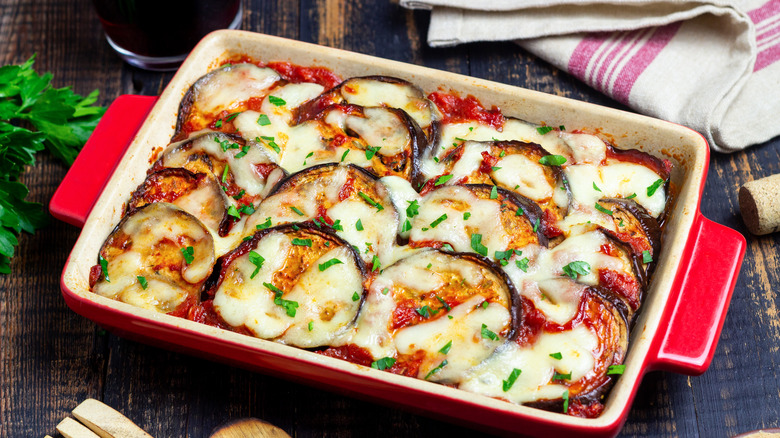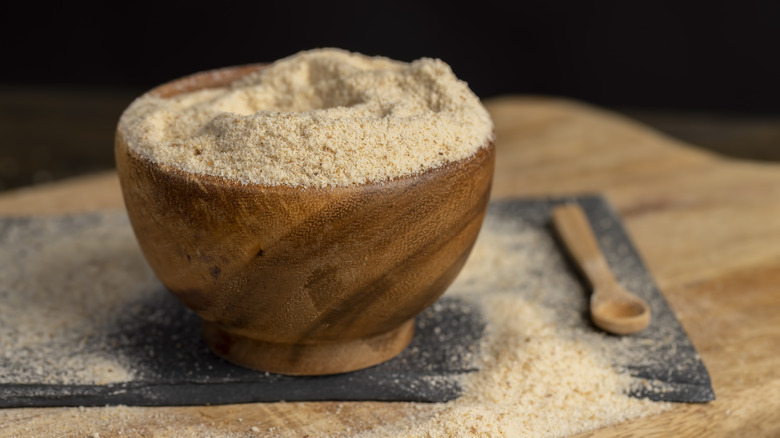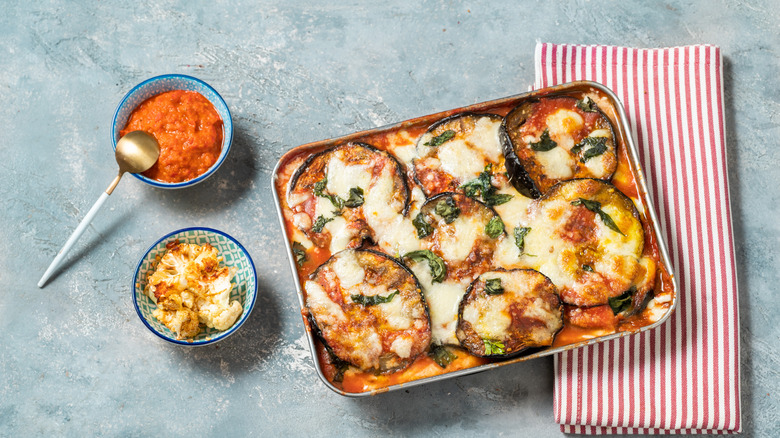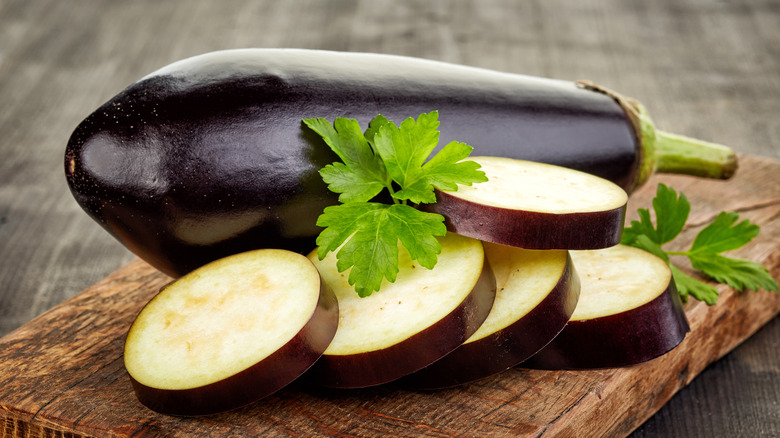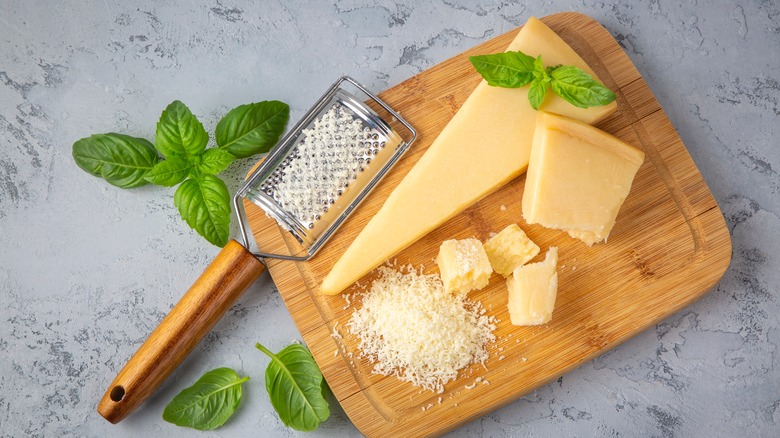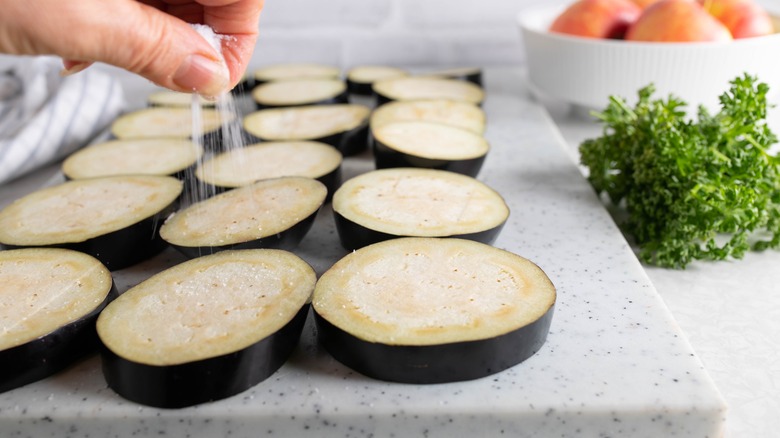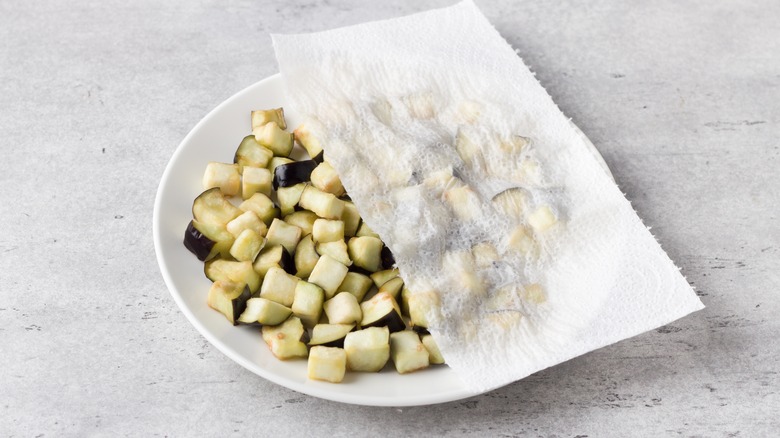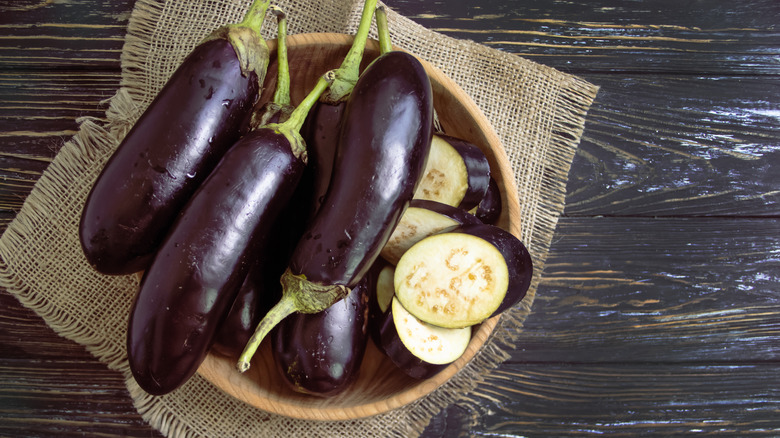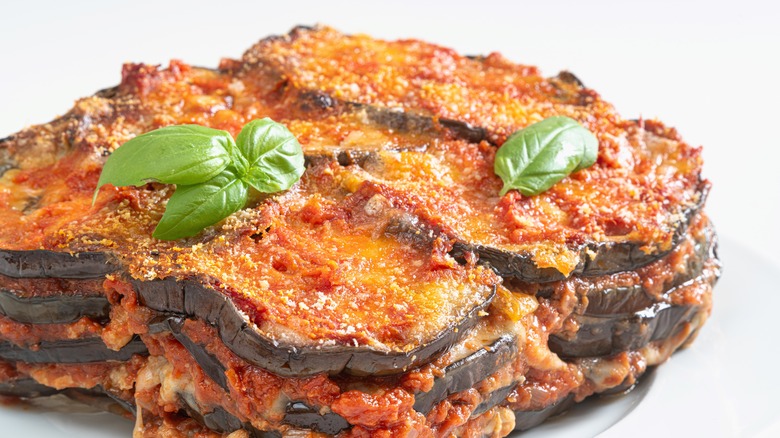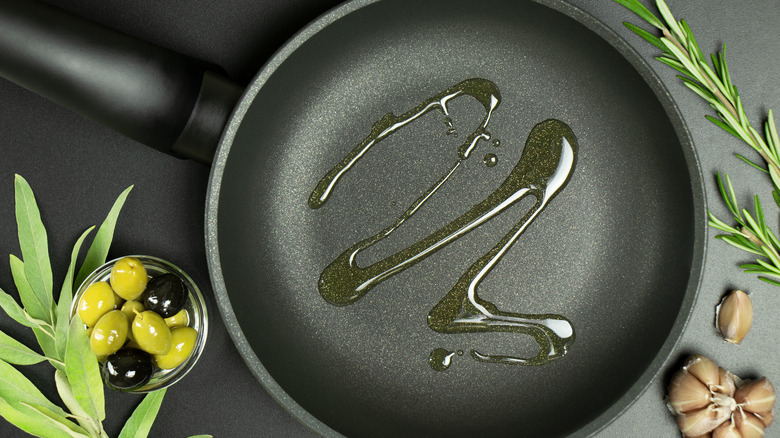You're Making The Same 10 Mistakes When Cooking Eggplant Parmesan
There's nothing quite like a perfectly executed eggplant Parmesan. But it's a labor of love that requires patience, multiple steps, and careful attention to detail. You're dealing with salting, rinsing, breading, frying or baking (or roasting, according to Ina Garten), layering, and then baking again. Each of these techniques presents its own opportunities for things to go sideways, and even experienced home cooks can find themselves staring at a disappointing result after hours of work.
What makes this dish particularly tricky is that the mistakes are surprisingly easy to make. We're talking about seemingly small details that can completely transform your final dish. Skip one step, rush through another, or make a minor miscalculation with ingredients, and suddenly your beautiful eggplant Parmesan turns into a soggy, greasy, or tough disappointment.
Many of these errors seem minor in the moment. Using pre-grated cheese instead of fresh? What's the big deal? Skipping the salting step to save time? Surely it won't matter that much. But these apparently insignificant choices can have major impacts on your final result.
Here are the most common mistakes you should avoid to make sure all that hard work pays off. When eggplant Parmesan turns out perfectly, it's one of the most satisfying and delicious dishes you can make. Understanding these pitfalls will help ensure your next attempt achieves a perfect restaurant quality result every single time.
Selecting sub-par breadcrumbs
You might think using store bought breadcrumbs is a harmless convenience, but think again. Commercial versions are often ground so fine they create a pasty coating rather than the gorgeous crispy crust that makes this dish special. Plus, they usually have that slightly stale, off flavor that no amount of seasoning can disguise.
For eggplant Parmesan, the breadcrumb texture is especially important. The whole magic of this dish comes from the contrast between tender, silky eggplant and that satisfying crunch from the golden outer layer. Proper breadcrumbs provide that perfect texture that makes each bite so satisfying.
Making your own breadcrumbs is simple and quick. Just grab a hearty, sturdy sandwich loaf with some character to it. Avoid the super soft, squishy sandwich breads that compress into doughy balls. A good Italian bread, sourdough, or even day-old baguette works beautifully.
If you really must use store-bought, Japanese panko breadcrumbs make a decent substitute. Their flaky texture gets you much closer to homemade than the standard store-bought variety. Whatever breadcrumbs you use, season them generously with freshly grated Parmesan and Italian herbs like oregano, basil, and thyme. When coating your eggplant slices, make sure you're getting enough breadcrumb coverage. Each slice should have an even, generous coating that completely covers the surface. If you can still see the eggplant through the crumbs, add more.
Cutting corners on the sauce
That jar of pre-made sauce might be convenient, but it's holding your eggplant Parmesan back from greatness. Homemade sauce is easy and wonderfully customizable — want it garlicky? Throw in a few extra cloves. Love herbs? Add fresh basil and oregano. Craving that mysterious depth of flavor? A couple of anchovies will dissolve completely and add incredible umami without any fishiness. But whatever ingredients you choose, one rule is a non-negotiable — give that sauce time to simmer.
At least 20 minutes of gentle bubbling is absolutely essential, and here's why. First, heat transforms raw tomato flavor into something deeper and more complex. Those harsh acidic notes mellow out, the natural sweetness emerges, and everything harmonizes beautifully. But equally important is what happens to the consistency. A properly simmered sauce will be nice and thick. This thickness is crucial for your eggplant Parmesan. If your sauce is too thin, not only will the flavor be weaker, but all that excess liquid will turn your carefully breaded eggplant into a soggy mess. Nobody wants to put all that effort into perfect crispy eggplant slices only to have them dissolve into mush.
Using too much sauce
We see it time and again. Someone puts all the effort into making beautiful crispy eggplant slices, only to drown them in a sea of sauce. Then comes the inevitable disappointment when they cut into what should be a layered masterpiece and find nothing but soggy mush. If your eggplant Parmesan lacks that satisfying textural contrast, over-saucing is the likely culprit.
The trick lies in showing some restraint. When adding that final layer of sauce on top, resist the urge to completely cover every inch of eggplant. Instead, leave some areas sauce-free, allowing those portions to maintain their delightful crispness. This creates a beautiful contrast of textures in each bite — some areas will be saucy and tender, while others stay crisp and golden.
For the sauce enthusiasts among us, there's an easy solution. Simply serve additional warm sauce on the side, letting everyone customize their portion to their preferred level of sauciness. This way, the integrity of your carefully constructed dish remains intact, while still satisfying those who believe more sauce is always better.
Cutting thick, uneven slices
Nothing ruins a bite of eggplant Parmesan faster than hitting a tough, undercooked chunk of eggplant hiding among perfectly tender pieces. If you've ever experienced this disappointing contrast, uneven slicing is almost certainly the culprit. It's one of those seemingly small details that can make or break your final dish.
When people complain about tough eggplant Parmesan, they're usually describing undercooked eggplant. The problem typically stems from cuts that are too thick or inconsistent. Thick slices simply don't cook through completely in the time it takes to prepare the dish, leaving you with that unpleasantly firm texture that no amount of sauce can disguise.
The sweet spot for eggplant slices falls between ¼ and ½ inch in thickness. Any thinner and they might disintegrate during cooking; any thicker and you risk that dreaded undercooking. But perhaps even more important than the specific thickness is consistency across all your slices. Even cooking requires even slicing, so take your time to ensure all pieces are uniform.
How can you tell when eggplant is properly cooked? Perfectly done eggplant should offer very little resistance when pierced with a fork. The texture should be creamy and tender throughout, with no firmness in the center. Visually, the flesh loses its spongy appearance and becomes more translucent rather than opaque white.
Using pre-grated cheese
We know it's tempting to reach for that convenient container of pre-grated cheese when making eggplant Parmesan. After all, it saves a little time and effort, right? The thing is, the convenience doesn't pay off. Freshly grated cheese delivers dramatically better flavor than its pre-packaged counterpart. High-quality, freshly grated cheeses provide deeper, more complex flavors with rich, nutty, and savory notes. And this depth is simply lost in pre-grated versions.
Those bags of shredded cheese contain additives you probably never considered. Manufacturers add anti-caking ingredients like powdered cellulose and natamycin to prevent the cheese from clumping together in the package. While effective for that purpose, these additives also interfere with how the cheese melts. Instead of that glorious, creamy texture you want in your eggplant Parmesan, pre-grated cheese often melts unevenly or becomes slightly grainy.
There's also the freshness factor to consider. The minute cheese is grated, it starts to lose its flavor. With every day that pre-grated cheese sits on the supermarket shelf, its potency diminishes. The increased surface area exposed to air accelerates this staling process, leaving you with a pale shadow of what the cheese should taste like.
In a dish like eggplant Parmesan, where cheese is undeniably one of the starring ingredients, using the highest quality version makes a noticeable difference. The solution is simple. Buy a chunk of good parmigiano reggiano or pecorino and grate it yourself just before using. The few extra minutes this takes will reward you with dramatically better flavor and texture. For those following a plant-based diet, try out our vegan Parmesan alternative made with nutritional yeast for a similar umami kick.
Not sweating the eggplant
Do we really need to salt our eggplants? Some recipes suggest skipping this step, claiming modern eggplants are less bitter than their ancestors. But when it comes to eggplant Parmesan specifically, this step isn't just about bitterness. It's absolutely crucial for texture, flavor, and the overall success of your dish. Salting eggplant, also called "sweating," draws out excess moisture and concentrates flavor. Think about it. Eggplant is basically a sponge, and a watery sponge makes for soggy eggplant Parmesan. Nobody wants that after all your hard work.
The process is simple but requires a bit of patience. Slice your eggplant and sprinkle generously with salt — about ½ teaspoon per eggplant. Place them in a colander with a bowl underneath to catch the liquid and let them sit for at least 30 minutes. You'll know your eggplant is properly sweated when you see all the water that has been released.
This salting process does more than remove moisture. It actually begins breaking down the eggplant's cellular structure, which helps it fully soften during cooking. This is true whether you're roasting your eggplant slices for a lighter version or frying them for a more traditional approach. It is also crucial for achieving that coveted crispy exterior. When you remove the excess moisture, the eggplant is less likely to release water during frying, which helps the breading stay crisp and prevents it from becoming soggy.
Forgetting to rinse the eggplant
We see it way too often. Someone diligently salts their eggplant, lets it sit properly, and then rushes right to the breading stage without removing that salt. This simple oversight can turn your carefully crafted eggplant Parmesan into an inedible salt bomb. After sweating your eggplant, always take the time to rinse or wipe away the excess salt.
You have two perfectly good options for this step. The first method is simply rinsing your eggplant slices under cool water. This quickly and effectively removes all the surface salt and the bitter juices that have been drawn out. The second approach is gently mopping the eggplant with paper towels, wiping away the salt crystals and moisture. Both techniques work well. But if you skip this rinsing step, your finished dish will be overwhelmingly salty and potentially inedible.
Whichever method you choose for removing the salt, there's one crucial follow-up step. You must thoroughly dry your eggplant before moving forward. Pat each slice dry with clean paper towels, pressing gently to absorb as much moisture as possible. This drying step is absolutely essential because wet eggplant simply won't brown properly. The breadcrumbs won't adhere well, the coating will steam rather than crisp, and all your careful preparation will be undermined.
Not picking the best eggplant
The perfect eggplant should feel firm and surprisingly heavy for its size. Look for a uniform, dark purple color and smooth, shiny skin. One particularly valuable tip comes from a Reddit user on a thread discussing the dish, who shared their Italian mother's secret: "My mom (born and raised in Italy) makes a to-die-for eggplant Parm. Her big secret is to find the eggplant at a dedicated fruit and vegetable stand, and choose the smallest possible. In spring/summer the smallest ones are easier to find. The Big Bois are dry and astringent and need all that over salting and patting to make them palatable. The smaller ones will get you to the melt in your mouth texture you're looking for." This advice aligns with what many cooks recommend.
Timing matters, too. In the United States, peak eggplant season runs from May to October, when you'll find the freshest, most flavorful options. During these months, farmers markets are excellent sources for just-picked specimens.
Once you've selected your perfect eggplant, proper storage is key. Place it in a cool spot on your counter, away from direct sunlight. For maximum air circulation, set it in a colander. If you must store it in the refrigerator, loosely wrap it in plastic wrap and either put it on the top shelf where it is warmest, or the vegetable drawer where there is the most humidity. Even with proper storage, eggplants have a brief shelf life of about two days at room temperature, so plan to use them quickly after purchase.
Serving it before it gets a chance to rest
That beautiful eggplant Parmesan comes out of the oven all bubbly and golden, and everyone at the table is ready to dig in — but wait! If you grab your serving spoon right away, you might be setting yourself up for disappointment. The difference between a messy, structureless scoop and a perfect, Instagram-worthy slice often comes down to one simple thing: patience.
Allow your eggplant Parmesan to rest for 15 minutes after it comes out of the oven. This brief cooling period might seem unnecessary when hungry people are waiting, but it's crucial for the final presentation. During this time, loosely cover the dish with aluminum foil to keep it warm while still allowing some heat to escape.
This resting period serves an important purpose. It helps the eggplant Parmesan maintain its structure when serving. The cheese and marinara sauce need time to set properly, which results in cleaner slices and prevents the layers from sliding apart when transferred from dish to plate. Without this setting time, all your careful layering can turn into a delicious but messy pile on the plate.
Think of it like letting a cake cool before frosting it or resting a steak before cutting. Some things simply can't be rushed if you want the best results. The good news is that this waiting period is the perfect opportunity to finish up other elements of your meal. Toss that last-minute salad, warm up some crusty bread and pour the wine. By the time these final touches are complete, your eggplant parmesan will be perfectly set and ready to serve.
Not getting the oil hot
If you are going to fry your eggplant rather than bake it, there is one mistake you need to avoid — not getting your pan and oil hot enough before adding the eggplant. This simple mistake will turn your beautiful breaded slices into greasy sponges.
The science is straightforward. Eggplant is naturally porous, which means it's programmed to absorb whatever it touches. When you place eggplant in oil that isn't hot enough, it soaks up the oil like a sponge. They key is to use just a slick of oil that is properly heated to 365 F to 375 F, the intense heat immediately creates a barrier by cooking the exterior rapidly, forcing moisture out rather than letting oil seep in.
Not sure if your oil is hot enough? Drop a small piece of bread or eggplant into the oil. It should bubble actively around the food and the piece should begin browning within about 30 seconds.
When selecting oil, stick with options that have high smoke points and neutral flavors. Grapeseed oil and vegetable oil are excellent choices. Remember to avoid overcrowding the pan. Each slice needs space around it for the oil to maintain its temperature and for steam to escape. Working in batches takes a bit longer but makes all the difference. This attention to temperature might seem fussy, but it's the difference between eggplant that drinks up half a bottle of oil and eggplant that develops a beautiful golden crust while staying light and crisp.

